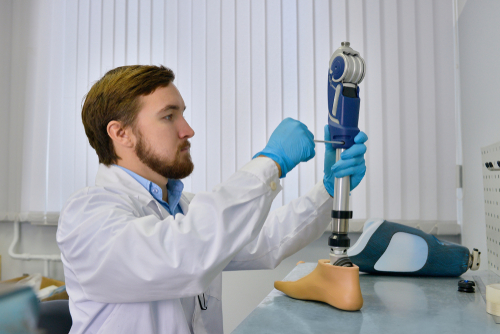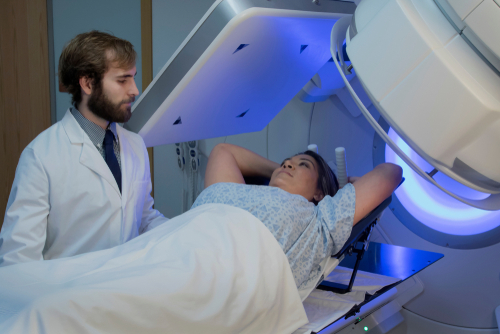
The steady rise in Healthcare Positions means that it is the largest area of economic growth in the United States. According to the Bureau of Labor Statistics (BLS), the average rate of growth for all professionals throughout the country is 11 percent. The ranges for growth in the Healthcare Sector are significantly higher with many healthcare jobs predicted to rise 30 to 40 percent over the next ten years. Data from the BLS outlines a number of healthcare jobs that will see the greatest amount of growth from now until 2022. Information on salary, predicted growth and position details were gathered from the 2015 Bureau of Labor Statistics Occupational Handbook. This list highlights the top 20 healthcare jobs that are predicted to see the highest rates of job growth over the next ten years. Also included is the number of new jobs that will be created out of this rise, the mean annual salary, the mean hourly wage and the educational level required to pursue this healthcare position. Anyone with an interest in pursuing a career in the healthcare industry can use this information to choose which healthcare job is the right one for you.
Personal Care Aid
Predicted Rise: 49%
Personal care aides are individuals who help patient’s complete self-care and everyday tasks, as well as offer personal companionship to those who lack regular interactions. Personal care aides are responsible for the following:
- Aid and assist patients in various ways with cognitive impairments, such as Alzheimer’s or mental illness
- Offer companionship to patients by engaging in conversation, playing games, going for walks as well as a number of other social interactions
- Help patients with tasks related to hygiene, such as bathing, brushing teeth, and going to the bathroom
- Help transfer patients from a bed to a wheelchair or from one room to another
- Complete housekeeping tasks, such as changing bed linens, washing dishes, and cleaning living areas
- Help prepare and plan meals
- Help organize and plan a patient’s schedule and make all necessary appointments
- Arrange transportation to doctors’ offices or to the store
- Help clients pay bills or manage money
- Shop for personal items and groceries
Personal care aides, also referred to as homemakers, caregivers, companions, and personal attendants, offer those in need the critical companionship and daily task assistance that can make a huge difference in their quality of life. In many cases these aids work in conjunction with other healthcare, hospice or social workers that visit a client’s home and provide direct care. Personal care aides complete tasks that are similar to those done by home health aides, however personal care aides are not qualified to offer any type of medical service. Over the next ten years this area of employment is expected to boom, with a predicted rise of almost 50 percent and almost 600,000 new jobs.
Predicted New Jobs Created: 580,800
Average Annual Salary: $19,910
Average Hourly Wage: $9.57
Required Educational Level: High School Diploma
Home Health Aide

Predicted Rise: 48%
Home health aides are a blend of medical professional and personal care assistant. They generally support individuals who are disabled, chronically ill, or cognitively impaired. They often assist elderly patients who require personal and/or medical assistance. In some states throughout the country, home health aides can administer medication or monitor vital signs under the direction of a nurse or other healthcare practitioner. Home health aides typically do the following:
- Help patients complete daily personal tasks, such as bathing, toileting or dressing
- Provide essential medical services depending upon the needs of the patient, which can include checking vital signs or administering prescribed medication at scheduled times
- Assist with light housekeeping, such as helping with laundry, washing dishes, and light housework
- Help organize a patient’s personal schedule and help schedule necessary appointments
- Arrange transportation to doctors’ offices or other necessary outings
- Shop for groceries and prepare meals to a client’s dietary specifications
- Offer companionship when necessary
Home health aides typically work for certified home health or hospice agencies, many of which use government funding and must adhere to national or statewide medical regulations. These aides function under the immediate supervision of medical professionals, generally a registered nurse. Home health aides are required to maintain records of services rendered and report on their patients’ condition and progress to their supervising nurse or doctor. Home health aides also work closely with therapists (such as occupational or physical therapy) as well as any other medical staff, social workers, etc. The BLS predicts that this area of employment will see one of the biggest jumps over the course of the next ten years. With expected growth of at least 48 percent, there will be over 400,000 new Home Health Aide positions available to qualified professionals.
Predicted New Jobs Created: 424,200
Average Annual Salary: $20,820
Average Hourly Wage: $10.01
Required Educational Level: High School Diploma
Occupational Therapy Assistant or Aide
Predicted Rise: 41%
Most consumers of medical services have seen a shift from being treated solely by doctors to often being treated by nurse practitioners or physician assistants. The field of Occupational Therapy (OT) is seeing a similar shift toward a system of one trained Occupational Therapist supervising a number of Occupational Therapy Assistant or Aides, who provide direct care. Occupational therapy assistants and aides help patients acquire, recover, and improve their daily living skills. OT assistants work directly in the process of providing therapy to patients, while OT aides often perform support activities. Both assistants and aides work under the direction of occupational therapists. Occupational therapy assistants typically do the following:
- Help patients complete therapeutic activities, such as stretches and other exercises
- Lead children who have developmental disabilities in play activities that promote coordination and socialization
- Teach patients how to use special equipment or adaptive equipment
- Record patients’ progress, report to occupational therapists, and do other administrative tasks
Occupational therapy aides typically do the following:
- Prepare treatment areas, such as setting up therapy equipment
- Transport patients
- Clean treatment areas and equipment
- Help patients with billing and insurance forms
- Perform clerical tasks, including scheduling appointments and answering telephones
OT assistants work very closely with Occupational Therapists to create and implement patient treatment plans. These plans include a wide range of daily living tasks, ranging from teaching the most efficient way for patients to move from a bed into a wheelchair to the best way to stretch their muscles to meet their medical needs. OT assistants often work with individuals who have been diagnosed with learning disabilities to teach them skills that allow them to become more independent. With the expectation that this career will grow up to 41 percent in coming years, more and more OT Assistants and Aides will be needed to fill the new positions.
Predicted New Jobs Created: 49,400
Average Annual Salary: $39,430
Average Hourly Wage: $18.96
Required Educational Level: Associate’s Degree or Certification
Physical Therapy Assistant or Aide

Predicted Rise: 41%
Physical therapist assistants (sometimes called PTAs) and physical therapist aides work under the direction and supervision of a professional Physical Therapists. The system PT aides and assistants is seeing a very similar shift to what is listed above in the section for Occupational Assistants and Aides. PTA’s work with patients who are recovering from injuries and illnesses so they may regain movement and manage pain. They are involved in the direct care of patients, as well as completing tasks that are indirectly related to patient care, such as cleaning and setting up the treatment area, moving patients, and performing clerical duties. Physical therapist assistants typically do the following:
- Observe patients before, during, and after therapy, then reporting their observations to the supervising physical therapist
- Help patients complete exercises that are included in their plan of care
- Use a range of specific techniques, such as massage and stretching, to treat patients
- Use devices and equipment, such as walkers, to help patients
- Educate a patient and family members about what to do after treatment
Physical therapist aides typically do the following:
- Clean treatment areas and set up therapy equipment
- Wash linens
- Help patients move to or from a therapy area
- Do clerical tasks, such as answering phones and scheduling patients
Physical therapist assistants work closely with physical therapists to provide care to patients, often providing therapy through exercise, massage, gait and balance training, and therapeutic modalities, such as electrical stimulation and ultrasound. PTA’s must keep careful records of patients’ progress and report the results of each session to the supervising physical therapist. There will likely be an increase of just under 50,000 new PTA positions over the course of the next ten years.
Predicted New Jobs Created: 49,400
Average Annual Salary: $39,430
Average Hourly Wage: $18.96
Required Educational Level: Associate’s Degree or Certification
Genetic Counselor
Predicted Rise: 41%
Genetic counselors are master’s level professionals who assess individual or family risk for a variety of inherited conditions, such as genetic disorders and birth defects. These highly skilled professionals provide information and advice to other healthcare providers, as well as directly to individuals who may be concerned with the risk of inherited conditions. Genetic counselors typically do the following:
- Analyze genetic information to identify patients or families at risk for specific disorders and conditions
- Write comprehensive reports to describe complex genetic concepts for patients or referring physicians
- Discuss diagnostic options and the possible risks, rewards, and limitations with patients and families
- Interview patients to obtain thorough medical histories and document all relevant findings
- Interpret laboratory results and communicate findings to patients or physicians
- Counsel patients and family members by providing information, education, or reassurance regarding genetic risks and inherited conditions
- Determine patient treatment plans by reviewing laboratory work, literature, and patient histories
- Participate in professional organizations or conferences to keep abreast of developments in genetics and genomics
Genetic counselors are highly trained professionals who work to identify specific genetic disorders or syndromes through the study of genetics. For expecting parents, these counselors can use genetic testing to predict whether a child is likely to be born with hereditary disorders, such as Down syndrome and cystic fibrosis, as well as many others. Genetic counselors can also test whether an adult is likely to develop chronic disease or cancer. Studying patients’ genes through DNA testing identifies these conditions and in many cases Genetic Counselors perform the lab tests themselves. This field is anticipated to grow by approximately 41 percent from now until 2022, with as many as 56,800 new positions to be filled.
Predicted New Jobs Created: 900
Average Annual Salary: $56,800
Average Hourly Wage: $27.31
Required Educational Level: Master’s Level Degree
Diagnostic Medical Sonographer and Cardiology Technologists and Technicians

Predicted Rise: 39%
This grouping of diagnosticians includes a range of highly trained professionals including Diagnostic medical sonographers, cardiovascular technologists and technicians and vascular technologists. Each of these positions requires the operation of special imaging equipment to create images or conduct diagnostic tests. These various images and test results produce diagnostic images that are used to help doctors assess and diagnose medical conditions. In some cases technologists work directly with physicians and surgeons during surgical procedures. Diagnostic medical sonographers and cardiovascular technologists and technicians are responsible for:
- Prepare patients for medical procedures by completing patient histories and answering the patients questions about their upcoming procedure
- Set up and maintain diagnostic imaging equipment
- Use highly specialized equipment to gather diagnostic images or conduct medical tests
- Interpret images and test results to be used by physicians and other medical professionals
- Report findings of abnormal diagnostics to doctors or medical professionals
- Analyze and record diagnostic data to outline a summary of findings for physicians
- Record findings and keep track of patients’ records
Diagnostic medical sonographers are trained in the creation of images of the body’s internal organs and tissues. These images, known as sonograms or ultrasounds are often the first diagnostic test performed to look for a disease or abnormality. The following are examples of types of diagnostic medical sonographers:
Abdominal sonographers specialize in diagnostic testing in a patient’s abdominal cavity and related organs, such as the kidney, liver, gallbladder, pancreas, or spleen. These sonographers may also help with biopsies or other examinations requiring ultrasound guidance.
Breast sonographers are trained in the imaging a patient’s breast tissues. This test can confirm the presence of cysts and tumors that may have been detected by the patient, physician, or a mammogram.
Musculoskeletal sonographers are specialists in imaging muscles, ligaments, tendons, and joints.
Neurosonographers complete diagnostic tests on a patient’s nervous system, including the brain and spinal cord. Many diseases they image are associated with premature births or birth defects.
Obstetric and gynecologic sonographers specialize in imaging the female reproductive system and pregnancy. Many pregnant women receive sonograms to track the baby’s growth and health.
Predicted New Jobs Created: 42,700
Average Annual Salary: $60,350
Average Hourly Wage: $29.02
Required Educational Level: Associate’s Degree
Physician Assistant
Predicted Rise: 38%
Physician assistants are commonly referred to as Pas. They are highly skilled medical professionals who practice medicine as part of a team, under the direct supervision of a physician or surgeon. They must complete master’s level training to learn how to examine patients, diagnose injuries and illnesses, and provide treatment. PA’s are responsible for:
- Reviewing and gathering data regarding a patients’ medical history
- Completing physical exams to monitor and assess a patients’ health
- Ordering and interpreting diagnostic tests, such as x-rays, ultrasounds or blood tests
- Diagnosing a patient’s injury or illness
- Giving treatment as needed
- Educating and counseling patients and their families regarding their health status
- Prescribing medications when necessary
- Monitoring and recording a patient’s progress
- Researching the latest treatments to ensure the quality of patient care
- Conducting or participating in outreach programs; talking to groups about managing diseases and promoting wellness
Physician Assistants practice under the direct supervision of a physician or surgeon with responsibilities and level of supervision varying from state to state. Physician assistants can work in all areas of medicine, including primary care and family medicine, emergency medicine, and psychiatry.
Predicted New Jobs Created: 33,300
Average Annual Salary: $90,930
Average Hourly Wage: $43.72
Required Educational Level: Master’s Level Degree
Orthotist or Prosthetist

Predicted Rise: 36%
Orthotists and prosthetists (O&P professionals) are responsible for designing medical supportive devices, including orthotics and prosthetics as well as fiting patients for these devices. Some of these devices can include artificial limbs (arms, hands, legs, and feet), braces, and other medical or surgical devices. Orthotists and prosthetists are responsible for:
- Evaluating and interviewing patients to determine their specific needs
- Measuring patients to create a medical device that has a customized design and fit
- Designing orthopedic and prosthetic devices based on doctors or surgeons prescriptions
- Creating a mold of the part of a patient’s body that will be fitted with a brace or artificial limb to create the best possible fit
- Selecting materials to be used for the orthotic or prosthetic device
- Fitting, testing, and adjusting devices on patients
- Helping patients learn how to use and maintain their devices
- Repairing or updating prosthetic and orthotic devices
- Documenting care in patients’ records
O&P professionals can work in both orthotics and prosthetics, or they may choose to specialize in one of the two areas. Orthotists are highly skilled in working with medical supportive devices, like braces or inserts. Prosthetists are specifically trained to work with prostheses, such as artificial limbs and other body parts.
Predicted New Jobs Created: 3,000
Average Annual Salary: $62,670
Average Hourly Wage: $30.13
Required Educational Level: Master’s Level Degree
Physical Therapist
Predicted Rise: 36%
Physical therapists (PT) help people who have sustained an injury or illness that has limited their movement, mobility or created chronic pain. PT’s are a critical part of rehabilitation and treatment for patients living with chronic conditions or injuries. Physical therapists often perform the follow:
- Gather and review relevant medical history information and review referrals or notes from doctors or surgeons
- Diagnose what is causing the patients limitation by observing them directly when in action as well as by having them list their concerns
- Create a care plan for the patient with patient’s goals and the predicted outcome of the plan
- Use exercises, stretching maneuvers, massage, and rehabilitation equipment to ease pain, increase mobility, prevent further pain or injury, and facilitate health and wellness.
- Evaluate progress and make adjustments to a care plan as needed
- Work with patients and their families to educate them about recovery process
Physical therapists provide direct patient care to individuals of varying ages who are suffering from mobility issues resulting from injuries or illness. This already large area of employment is expected to see an additional 73,500 positions over the next ten years.
Predicted New Jobs Created: 73,500
Average Annual Salary: $79,860
Average Hourly Wage: $38.39
Required Educational Level: Doctoral or Professional Degree
Audiologist

Predicted Rise: 34%
Audiologists are abundantly skilled medical professionals who work with patients to diagnose and treat hearing and balance issues, using special technology and procedures. Audiologists are typically responsible for the following:
- Examine patients with hearing, balance, or other ear difficulties
- Assess the results of diagnostic examinations and diagnose the cause of the problem
- Decipher and administer the best course of treatment
- Provide procedures to relieve the symptoms of various forms of vertigo
- Fit and dispense hearing aids
- Work directly with patients and families to help them learn to communicate better with techniques such as lip reading or American Sign Language
- Meet with patients regularly to evaluate their hearing and balance in order to decide whether to discontinue, continue or change the treatment plan
- Record patient progress
- Conduct research related to the causes and treatment of hearing and balance disorders
Audiologists typically receive doctoral level training so they can understand how to properly use audiometers, computer programs designed for this profession, and other related devices that will help assess patients’ hearing ability and balance. They also assess the extent of hearing damage and evaluate the possible causes. With an expected 34 percent jump in the field of audiology between now and 2022, there will be as many as 4,300 new positions in the field.
Predicted New Jobs Created: 4,300
Average Annual Salary: $69,720
Average Hourly Wage: $33.52
Required Educational Level: Doctoral or Professional Degree
Dental Hygienist
Predicted Rise: 33%
Anyone who has visited their dentist for a cleaning has encountered the services of a Dental Hygienist. These dental professionals are responsible for cleaning teeth, examining patients for signs of oral diseases such as gingivitis, explaining their findings to a supervising dentist and providing other preventative dental care. In many dental practices, Dental Hygienists are also the one that educates patients on how to improve and maintain good oral health. Dental hygienists typically perform the following tasks:
- Clean teeth and remove tartar, stains, and plaque from teeth
- Apply sealants and fluorides to help protect teeth, especially in young children
- Take and develop dental x-rays to assess for possible problems
- Monitor patient care and treatment plans
- Teach patients effective oral hygiene techniques
Dental hygienists are trained in how to use all of the necessary tools to perform their job effectively. During their training, they learn to clean and polish teeth with hand, power, and ultrasonic tools. This field will likely see growth upwards of 33 percent, which means there will be a growing need for more Dental Hygienists. Because the training necessary is an Associate’s Degree this is a field that yields excellent growth in earnings with minimal school debt.
Predicted New Jobs Created: 64,200
Average Annual Salary: $70,210
Average Hourly Wage: $33.75
Required Educational Level: Associate’s Degree
Nurse Anesthetist, Nurse Practitioner or Nurse Midwife

Predicted Rise: 32%
Nurse Anesthetists, Nurse Midwives, and Nurse Practitioners, are part of a larger group of nurses commonly referred to as Advanced Practicing Registered Nurses (APRN). APRN’s are responsible for coordinating patient care and directly providing primary and specialty health care. The level of responsibility an APRN can perform varies from state to state, however most Advanced Practice Registered Nurses can typically perform the following:
- Take and record patients’ medical histories and list of symptoms or problems in order to set up care plans patients’ or contribute to an existing care plan
- Carry out basic physical exams
- Observe patients and diagnose various health problems
- Perform and order diagnostic tests and analyze results
- Provide patients with necessary medicines and treatments
- Consult with doctors and other healthcare professionals as needed
- Operate and monitor medical equipment
- Offer counseling and educate patients on how to stay healthy or manage their illnesses or injuries
- Participate in research
APRNs can work either independently or in collaboration with doctors, depending upon state laws. In many states, they have the ability to prescribe medications, order medical tests, and diagnose health problems. They may also offer primary and preventative medical care with the ability to specialize their care to specific groups of people or patients with specific types of health disorders. By 2022, there will be at least 47,000 new open positions for properly trained APRN’s.
Predicted New Jobs Created: 47,600
Average Annual Salary: $96,460
Average Hourly Wage: $46.37
Required Educational Level: Master’s Degree
Surgical Technologist

Predicted Rise: 30%
Surgical technologists, also known as Operating Room Technicians, are individuals who hold a Post-Secondary Non-Degree Award in the field and are responsible for assisting in surgical procedures. They prepare operating rooms with the tools necessary for specific procedures, arrange equipment for surgery and help doctors during surgical procedures. Surgical technologists can also perform the following tasks:
- Sterilize equipment and make sure that all of the required supplies are readily available for surgery
- Prepare patients for surgery, such as by washing and disinfecting incision sites
- Help surgeons during surgery by handing them the proper instruments and other sterile supplies
- Count supplies such as sponges and instruments to maintain a sterile and safe surgical environment
Surgical technologists work as an important member of the surgical team alongside physicians and surgeons, registered nurses, and other healthcare workers. Before an operation can begin, a surgical technologist prepares the operating room by setting up surgical instruments and equipment. They many also ready a patient for surgery by washing and disinfecting incision sites, positioning patients on the operating table, covering patients with sterile drapes, and taking patients to and from the operating room. Surgical technologists prepare sterile solutions and any medications that will be used during surgery. With an expected jump of at least 30 percent over the next ten years, this is an excellent field for individuals who want to enter the medical field but do not want to spend several years in college.
Predicted New Jobs Created: 29,300
Average Annual Salary: $41,790
Average Hourly Wage: $20.09
Required Educational Level: Post-Secondary Non-Degree Award
Medical Assistant
Predicted Rise: 29%
Medical assistants are an increasingly important group of individuals who help a medical practice or hospital run smoothly. These assistants have a wide range of responsibilities including tasks such as administrative and clinical tasks in the offices of physicians, podiatrists, chiropractors, and other health practitioners. Their responsibilities vary depending upon the place of employment, the specialty area, and size of the facility or practice. Some of what a Medical Assistant might do an on a day-to-day basis includes:
- Complete patient histories and gather personal and medical information
- Monitor and record vital signs
- Help physician with patient exams
- Administer injections as directed by the physician
- Schedule patient appointments
- Prepare blood for laboratory tests
One important aspect of being a Medical Assistant is understanding the importance of confidentiality, where medical information can only be discussed with other medical personnel who are involved in treating the patient. Electronic health records (EHRs) are changing medical assistants’ jobs. As more physicians adopt the EHR system and move patient information online, assistants need to become familiar with EHR software.
In large medical practices or hospitals, Medical Assistants are often specialists in either administrative or clinical work. The next ten years will likely result in a huge jump in Medical Assistant Positions so there will be a great need for individuals trained in this area.
Predicted New Jobs Created: 162,900
Average Annual Salary: $29,370
Average Hourly Wage: $14.12
Required Educational Level: Post-Secondary Non-Degree Award
Occupational Therapist
Predicted Rise: 29%
Occupational Therapists (OT) are highly trained professionals who treat patients who have sustained an injury, illness, or disability. Their job is to use therapeutic techniques to help patients perform daily activities more efficiently. OT’s work directly with patients to help them develop, recover, and improve the skills needed for daily living and working. Some of the responsibilities of Occupational Therapists include:
- Use techniques such as observation and interview to start to understand what issues the patient needs addressed by the OT process
- Evaluate a patient’s specific concerns, condition and needs
- Create a treatment plan for each patient that outlines the types of activities and goals for treatment
- Work with individuals who have a long–term disabilities tackle various tasks so they can lead a more productive life
- Demonstrate exercises, such as joint stretches, strengthening exercises and massage to help relieve pain for people with chronic conditions
- Evaluate a patient’s home or workplace to identify potential improvements that can be made to ease their daily activities
- Educate a patient’s family or employer about how they can accommodate and care for the patient
- Recommend special equipment, such as wheelchairs and feeding aids, and teach patients how to properly use that equipment
- Evaluate and monitor patients’ activities and progress
OT’s regularly work directly with patients who have a permanent disability, such as cerebral palsy, to help them learn to perform daily tasks and become more independent. These therapists show patients how to use adaptive equipment, such as leg braces, wheelchairs, and eating aids.
Some Occupational Therapists work with young children in educational settings to assess and treat children’s disabilities, modify classroom equipment to accommodate children with disabilities, and help children participate in typical school activities. The next ten years will likely see significant growth in this field with as many as 33,000 new jobs becoming available.
Predicted New Jobs Created: 32,800
Average Annual Salary: $75,400
Average Hourly Wage: $36.25
Required Educational Level: Master’s Level Degree
Phlebotomist

Predicted Rise: 27%
Phlebotomists are those medical professionals who specialize in drawing blood for medical tests, transfusions, research, or blood donations. Phlebotomists typically perform the following tasks:
- Draw blood from patients and blood donors
- Interact with patients so they are less nervous about having their blood drawn
- Verify identity to ensure proper labeling
- Label the drawn blood for testing or processing
- Enter patient information into an onsite database
- Assemble and maintain medical instruments such as needles, test tubes, and blood vials
It is expected that over the course of the next ten years, the field of Phlebotomy will see as much as a 27 percent increase, which is more than double the national average. This means a number of new positions will be available to those with the proper training.
Predicted New Jobs Created: 27,100
Average Annual Salary: $29,730
Average Hourly Wage: $14.29
Required Educational Level: Post-Secondary Non-Degree Award
Licensed Practical Nurse or Licensed Vocational Nurse
Predicted Rise: 25%
Licensed Practical Nurses (LPNs) and Licensed Vocational Nurses (LVNs) are medical professionals who are responsible for providing rudimentary medical care directly to patients. They work under the direct supervision of a registered nurse and a doctor. Licensed Practical and Licensed Vocational Nurses are responsible for:
- Monitor patients’ health and take their vital signs
- Perform basic patient care, including changing bandages and inserting catheters
- Assisting patients with daily living activities, such as helping bathing or dressing
- Discuss the care they are providing with patients and listen to their concerns
- Record and report patients’ status and concerns to registered nurses and doctors
- Maintain updated medical records
The responsibilities’ of LPN’s and LVN’s vary greatly depending on the place of employment and the state of employment. These nurses can be found working in hospitals, medical practices, long term care facilities and many other settings. Between now and 2022, it is expected that these nursing specialties will grow by at least 25 percent with as many as 182,900 new positions becoming available.
Predicted New Jobs Created: 182,900
Average Annual Salary: $41,540
Average Hourly Wage: $19.97
Required Educational Level: Post-Secondary Non-Degree Award
Optometrist
Predicted Rise: 24%
Optometrists are doctoral level medical professionals who examine, diagnose, treat, and manage disorders of the visual system, eye diseases, and injuries. They also prescribe glasses or contact lenses as needed. Optometrists are responsible for the following:
- Perform vision tests and analyze results
- Diagnose vision difficulties, such as nearsightedness or farsightedness and eye diseases, such as glaucoma
- Prescribe eyeglasses, contact lenses, and ocular medications
- Provide treatments such as vision therapy or low-vision rehabilitation
- Provide before and after care to patients undergoing eye surgery
- Evaluate patients for the presence of ocular effecting diseases such as diabetes and refer patients to other healthcare providers as needed
- Promote eye health by counseling patients, including explaining how to properly clean and wear contact lenses
In many cases an optometrist provides more specialized care, specifically those working in a group practice with other optometrists or physicians. Over the next ten years the field of optometry will see growth upwards of 24 percent, which will create more than 8,000 new jobs.
Predicted New Jobs Created: 8,100
Average Annual Salary: $97,820
Average Hourly Wage: $47.03
Required Educational Level: Doctoral or Professional Degree
Radiation Therapist

Predicted Rise: 24%
Radiation therapists receive very specialized training so they may become experts in the treatment of cancer and other diseases by administering very specialized radiation treatments. Radiation therapists perform the following tasks, as well as many more depending upon their place of employment and specialization:
- Explain treatment plans to the patient and answer the patients questions about treatment
- Follow all safety precautions so the Radiation Therapist and patient are protected from possible overexposure to radiation
- Examine and monitor radiation machines to ensure they are safe and functioning properly
- Perform X-rays to determine the exact location of the area requiring treatment
- Direct the computer program to guide the machine to administer the correct amount of radiation to the appropriate area of the patient’s body
- Operate the machine to treat the patient with radiation
- Monitor the patient to check for unusual reactions to the treatment
- Keep detailed records of treatment
Radiation Therapists use highly specialized machines called linear accelerators to deliver radiation therapy. These machines emit high-energy x rays at specific cancer cells in a patient’s body, with the goal of shrinking or removing them. Radiation therapists work as part of a greater oncology team to treat patients with cancer. They often work with the following specialists:
Radiation oncologists – Physicians who specialize in radiation therapy
Oncology nurses – Registered nurses who specialize in caring for patients with cancer
Radiation physicists – Physicists who calibrate linear accelerators
Predicted New Jobs Created: 4,500
Average Annual Salary:$77,560
Average Hourly Wage: $37.29
Required Educational Level: Associate’s Degree
Medical and Health Services Manager
Predicted Rise: 23%
This steadily rising position is the only job on our list with the educational requirement of a Bachelor’s Degree. It awards the same high salary as many of the positions that require a higher degree of education and training. Medical and Health Services Managers are often referred to as Healthcare Executives, Healthcare Managers or Healthcare Administrators. These professionals are responsible for the planning, directing, and coordination of medical and health services. With the right educational level they are qualified to manage an entire facility or specialize in managing a specific clinical area or department, or manage a medical practice for a group of physicians. A large part of a Healthcare Managers job is to adapt to changes in healthcare laws, regulations, and technology. Healthcare Managers are responsible for the following:
- Work to improve efficiency and quality in delivering healthcare services
- Stay current on any new laws and regulations so that the facility in which they work complies with them
- Supervise assistant managers and administrators in facilities that are large enough to need them
- Manage the finances of the facility, such as patient fees and billing
- Create work schedules for medical providers of various levels
- Represent the facility at investor meetings or on governing boards
- Keep and organize records of the facility’s services, such as the number of inpatient beds used
- Communicate with members of the medical staff and department heads
Healthcare Managers working in group medical practices work directly with physicians and surgeons, registered nurses, medical and clinical laboratory technologists and technicians and other healthcare workers. A Healthcare Managers specific title depends largely on the facility or area of expertise in which they work. The following are some examples of types of medical and health services managers:
Nursing home administrators manage staff, admissions, finances, and care of the facility, as well as care of the residents in nursing homes. They must hold state licensure in order to fill this position.
Clinical managers oversee a specific department, such as nursing, surgery, or physical therapy, and have responsibilities based on that specialty. Clinical managers create and implement policies, goals, and procedures for their departments; evaluate the quality of the staff’s work; and develop reports and budgets.
Health information managers are responsible for the maintenance and security of all patient records. They must stay abreast of changing information technology and current or proposed laws about health information systems. Health information managers must ensure that databases are complete, accurate, and accessible only to authorized personnel.
Assistant administrators work under the top administrator in larger facilities and often handle daily decisions. Assistants might direct activities in clinical areas, such as nursing, surgery, therapy, medical records, or health information.
Predicted New Jobs Created: 73,300
Average Annual Salary: $88,580
Average Hourly Wage: $42.59
Required Educational Level: Bachelor’s Degree
As the healthcare industry continues to thrive and grow, there is a steady rise in healthcare jobs. If you add up the number of positions these growing professions will add to the healthcare sector over the next ten years, there will be 1,860,700 new healthcare jobs available. Considering this includes only 20 positions within this huge sector, it becomes obvious just how thriving this industry it. These positions range from entry-level positions with minimal educational requirements all the way to top-level positions that require advanced degrees and training. What this list shows us is that regardless of what level you plan to seek employment, there is a healthcare job at almost every level of education, pay and responsibility level. No matter what level you choose, you have the confidence that the industry will continue to thrive in coming years. The rise in healthcare jobs means that these positions are some of the wisest choices for future employees to consider.
About the Author
After earning a Bachelor of Arts in Psychology from Rutgers University and then a Master of Science in Clinical and Forensic Psychology from Drexel University, Kristen began a career as a therapist at two prisons in Philadelphia. At the same time she volunteered as a rape crisis counselor, also in Philadelphia. After a few years in the field she accepted a teaching position at a local college where she currently teaches online psychology courses. Kristen began writing in college and still enjoys her work as a writer, editor, professor and mother.